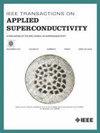Characterization of Adiabatic Quantum-Flux-Parametrons in the MIT LL SFQ5ee+ Process
IF 1.7
3区 物理与天体物理
Q3 ENGINEERING, ELECTRICAL & ELECTRONIC
引用次数: 0
Abstract
Adiabatic quantum-flux-parametron (AQFP) superconductor logic is a proven energy-efficient digital technology for various applications. To address the scalability challenges of this technology, we investigated AQFP shift registers with the AQFP footprint area reduced by 25% with respect to prior work and with the >2× denser overall circuit designs obtained by eliminating the previously used free space between the AQFPs. We also investigated AQFP cells with different designs of flux trapping moats in the superconducting ground plane as well as compact AQFP cells that took advantage of the smaller feature sizes available in the new fabrication process, SFQ5ee+, at MIT Lincoln Laboratory (MIT LL). This new process features nine planarized Nb layers with a 0.25 µm minimum linewidth. The fabricated circuits were tested in a liquid He immersion probe and a commercial closed-cycle cryocooler using a controlled cooling rate through the superconducting critical temperature,求助全文
约1分钟内获得全文
求助全文
来源期刊

IEEE Transactions on Applied Superconductivity
工程技术-工程:电子与电气
CiteScore
3.50
自引率
33.30%
发文量
650
审稿时长
2.3 months
期刊介绍:
IEEE Transactions on Applied Superconductivity (TAS) contains articles on the applications of superconductivity and other relevant technology. Electronic applications include analog and digital circuits employing thin films and active devices such as Josephson junctions. Large scale applications include magnets for power applications such as motors and generators, for magnetic resonance, for accelerators, and cable applications such as power transmission.
 求助内容:
求助内容: 应助结果提醒方式:
应助结果提醒方式:


